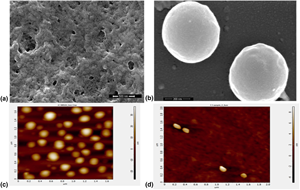Published online by Cambridge University Press: 29 June 2020

In this paper, the Lewis base character of 3-aminopropyltrimethoxysilane (3-APTMS), an imine derivative of siloxane, and an indole monomer were shown to enable the reduction of gold cations in acetone. The Lewis acid–base adduct of indole monomers and gold formed a polyindole–gold nanoparticle sol. Similarly, the Lewis acid–base adduct of 3-APTMS and gold enabled the formation of gold nanoparticles in the presence of acetone. The polyindole–gold nanoparticle sol and siloxane–gold nanoparticles underwent self-assembly into a polymeric nanofluid that was suitable for casting membranes. The use of these membranes as a potentiometric ion sensor for both cations and anions was considered; a common nonspecific ion exchange molecule, sodium tetraphenylborate, and the polymeric nanofluid were used to prepare an anion sensor and a cation sensor.